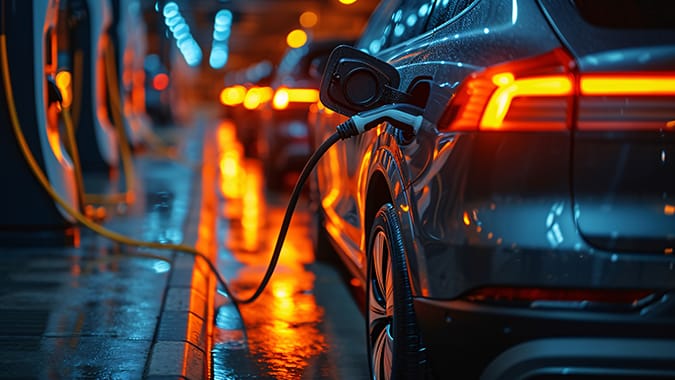Transitioning to electric vehicles will exacerbate declines in fuel tax revenue and boost demand for infrastructure funds, according to Syracuse University’s Dynamic Sustainability Lab, which urges states to plan for future transportation budget shortfalls.
The report says EV adoption rates vary by state (generally higher on the East and West coasts), but an eventual nationwide EV transition is “inevitable.” States, therefore, need to prepare for the budgetary challenges this change will bring because the fuel tax revenues that have traditionally funded transportation needs will decline as additional EVs and more fuel-efficient gas-powered and hybrid vehicles are placed on the road.
Where the EVs Are
The Syracuse study, with support from the Pew Charitable Trusts, examined the percentage of EVs in new car registrations in all 50 states as of the third quarter of 2023. New Jersey (13.24%) had the sixth highest share, behind Colorado (14.07%), Oregon (15.15%), the State of Washington (18.6%), and California (25.98%). Among all states, the national average for the EV share of new vehicle registrations was 9.28%.
Fuel Tax Collections
Revenue from state and local motor fuel tax revenue exceeded $53 billion nationwide in 2021. However, as gas tax revenues decline in the future from increased EV usage, infrastructure costs will rise. EVs weigh about 30% more than gas-powered vehicles, which increases maintenance costs for roads, highways, and bridges, the report said.
Additionally, states will need to install and maintain EV charging stations, upgrade utilities to support charging infrastructure, develop new revenue streams to offset fuel tax revenue losses, and deal with more potentially abandoned underground storage tanks after gas stations close, the report said.
Impact by State
To determine how the decline in fuel taxes would impact state budgets, the study examined what percentage of a state’s tax collections came from fuel taxes.
New Jersey may be better positioned than most states, according to the data. Motor fuel taxes represented only 0.88% of all tax revenues collected in New Jersey in 2021, which is tied with Hawaii for the lowest percentage of tax collections derived from fuel taxes.
In California, the state with the highest percentage of new EV registrations, motor fuel taxes represent 3.3% of all tax revenue collected. The states whose budgets are most reliant on gas tax revenues are South Dakota, Ohio, and Montana where gas tax revenues represent 8.83%, 7.23% and 7.07%, respectively, of all state taxes collected.
Modeling EV Adoption into Budgets
Because decreasing fuel tax revenues and increasing expenditures will create a budget gap, the Sustainability Lab recommends that states model their transportation budget shortfalls to see how different EV adoption rates would reduce fuel tax revenues and increase expenditures. Currently, only four states – California, Michigan, Rhode Island, and New York – are modeling the budgetary impact, the report said.
Revenue-raising options states have adopted or are considering to partially replace declining motor fuel revenues include:
- Road User Charges (RUCs). Vehicle owners are charged based on how many miles traveled per year, with mileage either self-reported or tracked via GPS units. Eight states have implemented or have piloted such programs (Washington, California, Colorado, Delaware, Hawaii, Oregon, Pennsylvania, and Minnesota).
- Annual EV Registration Fee. Often an additional fee on top of the annual registration fee, this has already been adopted by 32 states.
- Fuel Tax Increase. Unpopular with constituents, this places a greater financial burden on drivers of legacy internal combustion engine (ICE) cars and trucks.
- Electricity Sales Tax. Paid by users of EV charging units based on the amount of electricity they use. Adopted in four states: Georgia, Iowa, Montana, and Utah.
- Expansion of Road Tolls. This option would expand the number of miles of state highways and roads/bridges that charge tolls. The report says the technology is readily available to do this, but there would be capital costs to install sensors and there likely strong pushback from the public.
The Emerging Highway and Roads Revenue Gap white paper can be read at the Dynamic Sustainability Lab’s website. Information and interactive graphics about the findings can also be found on the Pew Charitable Trusts website here.




